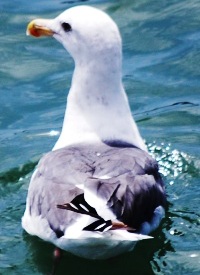(949) 675-0551 |
 |
DESCRIPTION: The adult Western Gull has a deep gray back that runs down the backside of the wings. The wings darken towards the end and are finished off with a black tip. The under wing is white with a narrow band of gray. The Western Gulls head is mostly white. The bill and eyes of a Western Gull are both yellow. The bill has a red spot located towards the front on the underneath portion. Western Gull takes four years to achieve adult plumage. Juveniles are mottled brown, with a dark bill and dark eyes, and pinkish-gray legs. This plumage varies and takes on more of the adult plumage characteristics each year. |
 |
RANGE/HABITAT: Western Gulls are found mostly near the coast, and also found regularly offshore. They are not typically found far inland. Many types of habitats are used, including estuaries, beaches, fields, garbage dumps, and city waterfronts. Nest sites are often located on rocky, sandy, or gravel islands, or inaccessible mainland cliffs. |
 |
BEHAVIOR: The Western Gull will steal unguarded eggs or chicks of other species. They scavenge city dumps and beaches for human food and possibly dead rodents. Western Gulls, like many other gull species, drop hard-shelled items from the air to break them on hard surfaces. |
 |
MATING/BREEDING: Western Gulls build their nests in colonies on islands, offshore rocks, and abandoned piers. Colonies are often located near nesting seabirds or sea lions. Western Gulls reach sexual maturity at 4 years of age. Nests are built on the ground, and the pair often starts as many as three nests, and then chooses one to finish and use. Nests are often located next to rocks or other object that provide protection from the wind and intruders. The nest is a mound built from nearby vegetation and debris. The female usually lays 3 eggs. Both sexes incubate the eggs for about a month. A few days after hatching, the young may leave the nest but won't go far, often hiding in nearby vegetation. At 6 to 7 weeks of age, they begin to fly, but don't become independent from their parents and depart the colony until they are 10 weeks or older. STATUS: The Western Gull is limited in distribution with a smaller population size than most other North American gulls, with a total population of only 80,000 worldwide, limited to about 200 colonies. The number of Western Gulls is difficult to determine. Some say that the population is stable or increasing. Others claim that the Western Gull is one of the most limited North American Gulls in range and population numbers. |
For Reservations Call: |
||
(949) 675-0551 |
||
Newport Beach Whale Watching 309 Palm St. #A - Newport Beach CA. 92661 |
||
Copyright © 2001 Newport Landing
Whale Watching |
Whale Watching | Whale Watching Dana Point Visitors | Whale Watching Long Beach Visitors | Whale Watching Los Angeles Visitors
Whale Watching San Diego Visitors | Huntington Beach Whale Watching | Whale Watching Laguna Beach | Catalina Island Whale Watching